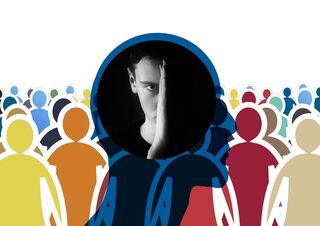Anxiety
What Teens With Social Anxiety Need During a Pandemic
These teens are comfortable avoiding their fears—for the moment.
Posted February 18, 2021 Reviewed by Matt Huston

Unlike many of his peers, James R doesn’t mind remote learning. In fact, the 16-year-old Massachusetts high school sophomore is thriving. He is relieved that he doesn’t have to face many of the casual daily high school encounters—like hallways, crowded classrooms, and a chaotic cafeteria—that often caused him to cringe. The weekly behavioral therapy that was helping him to overcome his fears by exposing him to social situations has been put on hold during the pandemic. So James is content to be a reclusive remote learner and play video games in his free time.
James is a typical teen with Social Anxiety Disorder (or SAD), and his relative comfort during the pandemic at the almost-one-year mark parallels that of many of my teen patients with this condition. According to the National Institute of Mental Health, over 9% of adolescents will be diagnosed with Social Anxiety Disorder before age 18. Misconceptions abound when it comes to this condition. Here are a few.
Having social anxiety isn’t the same as being an introvert. Introverts are generally comfortable in the presence of others, but crave alone time as well. And it isn’t the same as shyness. The difference is the degree of suffering. Shy teens don’t like being the center of attention, but also don’t worry intensely for weeks before attending a party or giving a speech.
At the core of SAD is a feeling of acute discomfort when observed by or in the company of others. Social anxiety can be generated across many domains, like meeting unfamiliar people, raising a hand in class, giving a speech, or even eating in front of others. Facing these situations can lead to intense anxiety, so avoiding them is far more comfortable. Being a teen has lots of pressures, and having to face intense fears of scrutiny and rejection at a vulnerable time in life can be devastating.
Why discuss social anxiety now? The pandemic has upended lives in so many ways, but it’s also provided opportunities for large natural experiments in human behavior. The rules by which we live our day-to-day lives have changed. For instance, even in communities where schools have remained open, there has generally been an increase in social distancing and therefore at least some reduction in social interaction. Researchers will be asking questions about how our mental health has—or hasn’t—changed during the pandemic for years to come.

Although we don’t yet have data to back up many of our hypotheses, it has been inescapable that almost all of my teenage patients with Social Anxiety Disorder resemble James R. While those with depression or Attention-Deficit Hyperactivity Disorder may remain symptomatic, I’ve seen patients with SAD experience a drop in distress.
That’s good for now, but what about the future?
Prolonged periods of sitting at home without opportunities to practice social skills can make it that much harder for teens with SAD to improve their ability to cope down the road. Dr. Samantha Coyle, an Assistant Professor of Psychology at Montclair State University in Montclair, New Jersey, believes that “it’s really important that we figure out ways to continue to provide students with the opportunity to interact and engage with others … one of the things that I think is really important is that social distancing doesn’t necessarily mean social isolation.”
Dr. Carrie Masia, Professor of Psychology at Montclair State University, agrees with Dr. Coyle. Masia says that it is important to find safe ways for socially anxious teens to keep practicing their social skills so they don’t lag behind on the developmental curve. She adds, “I would argue that if they’re home for one or two years without any social contact, we may see delays in milestones like forming close friendships or romantic relationships.”
There are ways that schools, parents, and therapists can act now to aid this vulnerable teen population. Teens with SAD are at risk for refusal to attend school—perhaps even more so following an extended period of time at home. According to Dr. Masia, “Anything the schools can do to maintain social contact between students during the pandemic and the re-entry point would be helpful.”
She and Dr. Coyle believe that school counselors should identify students who are at risk for school refusal and develop treatment plans with parents and outside therapists to aid re-entry. Dr. Masia, a proponent of school-based treatment for Social Anxiety Disorder, adds that a “re-entry group” for those at risk of substantial social anxiety or school refusal could also be important.
Keeping teens engaged socially during the pandemic is a tall order for overburdened parents. But it is important. Parents should encourage socially anxious teens to engage in volunteer opportunities, such as packing food at food banks, or to participate in sports like tennis or skating. Even video games shared with others can prop up social skills and provide much-needed (virtual) companionship.

Likewise, teens like James, who are already engaged in therapy, should continue treatment during the pandemic rather than wait for the world to return to “normal.” Therapists need to tap their creative skills to find socially challenging situations to aid their patients. Suggestions could include volunteering an answer in a Zoom class, picking up a takeout meal, or participating in an online birthday party.
It is vitally important that those with the knowledge and resources to help socially anxious teens do so now with energy, creativity, and purpose. The emotional development of millions of young people could be at stake.




